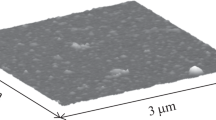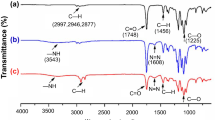Abstract
Hydrophobic polycations previously developed by us efficiently kill E. coli and Staphylococcus aureus on contact. As visualized by electron microscopy herein, these pathogenic bacteria incur marked morphological damage from the exposure to these N-alkylated-polyethylenimine “paints” which results in the leakage of an appreciable fraction of the total cellular protein. The quantity and composition of that leaked protein is similar to that released upon traditional lysozyme/EDTA treatment, thus providing insights into the mechanism of action of our microbicidal coatings.


Similar content being viewed by others
References
Belaaouaj AA, Kim KS, Shapiro SD (2000) Degradation of outer membrane protein A in Escherichia coli killing by neutrophil elastase. Science 289:1185–1187
Glenn AR (1976) Production of extracellular proteins by bacteria. Annu Rev Microbiol 30:41–62
Haldar J, An DQ, de Cienfuegos LA, Chen JZ, Klibanov AM (2006) Polymeric coatings that inactivate both influenza virus and pathogenic bacteria. Proc Natl Acad Sci USA 103:17667–17671
Haldar J, Weight AK, Klibanov AM (2007) Preparation, application and testing of permanent antibacterial and antiviral coatings. Nat Protoc 2:2412–2417
Jorgensen L, Oneill BK, Thomas CJ, Morona R, Middelberg APJ (1995) Release of chloramphenicol acetyl transferase from recombinant Escherichia coli by sonication ad the French press. Biotechnol Tech 9:477–480
Klibanov AM (2007) Permanently microbicidal materials coatings. J Mater Chem 17:2479–2482
Lin J, Qiu SY, Lewis K, Klibanov AM (2002) Bactericidal properties of flat surfaces and nanoparticles derivatized with alkylated polyethylenimines. Biotechnol Prog 18:1082–1086
Malamy MH, Horecker BL (1964) Release of alkaline phosphatase from cells of Escherichia coli upon lysozyme spheroplast formation. Biochemistry 3:1889–1893
Milovic NM, Wang J, Lewis K, Klibanov AM (2005) Immobilized N-alkylated polyethylenimine avidly kills bacteria by rupturing cell membranes with no resistance developed. Biotechnol Bioeng 90:715–722
Park D, Wang J, Klibanov AM (2006) One-step, painting-like coating procedures to make surfaces highly and permanently bactericidal. Biotechnol Prog 22:584–589
Schmitt B (1976) Pyruvate dehydrogenase in Escherichia coli—an active 17S species in crude extracts. Biochimie 58:1405–1407
Thomas M, Lu JJ, Ge Q, Zhang CC, Chen JZ, Klibanov AM (2005) Full deacylation of polyethylenimine dramatically boosts its gene delivery efficiency and specificity to mouse lung. Proc Natl Acad Sci USA 102:5679–5684
Vollmer W, Blanot D, de Pedro MA (2008) Peptidoglycan structure and architecture. FEMS Microbiol Rev 32:149–167
Yamato I, Anraku Y, Hirosawa K (1975) Cytoplasmic membrane vesicles of Escherichia coli: I. A simple method for preparing the cytoplasmic and outer membranes. J Biochem 77:705–718
Acknowledgments
This work was partly supported by the U.S. Army through the Institute of Soldier Nanotechnology at the Massachusetts Institute of Technology under contract DAAD-19-02-D0002 with the Army Research Office. J.O. is grateful to the China Scholarship Council and to the Beijing Forestry University for an Overseas Visiting Scholarship. We wish to thank Joey Cotruvo and Rachael Buckley for assistance with the French press experiments.
Author information
Authors and Affiliations
Corresponding author
Rights and permissions
About this article
Cite this article
Hsu, B.B., Ouyang, J., Wong, S.Y. et al. On structural damage incurred by bacteria upon exposure to hydrophobic polycationic coatings. Biotechnol Lett 33, 411–416 (2011). https://doi.org/10.1007/s10529-010-0419-1
Received:
Accepted:
Published:
Issue Date:
DOI: https://doi.org/10.1007/s10529-010-0419-1




